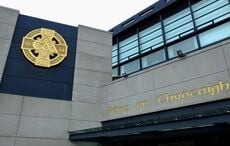The most visible difference between the police forces of Ireland, Scotland and the United States is obvious: the Scottish and Irish police are unarmed, a full 98 percent of the country's officers do not carry guns.
Instead of drawing guns at the first sign of conflict Irish and Scottish police are trained to turn to talk to de-escalate a confrontation, and a contingent of police leaders from across the US traveled to Scotland last week to see just how successful they have been at it.
There's a reason for their refusal to carry weapons. In Scotland, unlike America, a mass shooting at a school in Dunblane in 1996 led to even stricter gun laws, including for law enforcement.
Asked how many officers in Scotland have been killed in the last year or two Bernard Higgins, an assistant chief constable, told The New York Times that his officers routinely take punches, but the last one killed by violence was in 1994, in a stabbing.
Just as in the United States there is is poverty, crime and a “pathological hatred of officers wearing our uniform” in parts of Scotland, but Scottish police officers also live where they work and they see themselves as “guardians of the community,” he said.
“The basic fundamental principle, even in the areas where there’s high levels of crime, high levels of social deprivation, is it’s community-based policing by unarmed officers,” Constable Higgins told the Times. “We police from an absolute position of embracing democracy.” The us versus them approach is never taken.
In the United States, a dramatic spike in fatal police confrontations has enraged the public this year and has led US law enforcement leaders to reexamine their tactics on when and how to use force.
Read more: America needs its own peace process for gun control
Scottish police offered their perspective to their US visitors: The way officers think matters more than the weapons they carry, even in a nation where knives, not guns, are a criminal's weapon of choice.
“If you speak about a protest, for instance, the protest of the blacks in the street, well that’s about justice, unfairness,” Kirk Kinnell, the superintendent of Police Scotland told the press. “I would say, ‘That message, we should embrace that,’ because actually, as police officers, we want fairness. That’s why we joined.”
None of the officials from the United States discussed the national trend to militarize the police force with war grade armaments and transport, instead they focused on situations where civilians are armed with a knife or a bat and conflict needs to be deescalated.
The Scottish visit was reportedly the idea of Chuck Wexler, executive director of the Police Executive Research Forum, who visited last year on a leadership program.
Speaking to a Scottish police recruit, Wexler noticed he had no gun on his belt. “It hit me like a ton of bricks,” Wexler said.
Wexler says he sees a historic opportunity for American police officers to shift their thinking on culture, tactics and training. “We must do better,” he told the Times and his fellow American attendees agreed. In 2015 multiple videos captured on cell phones showed officers using excessive force or aggression.
Scottish police do not talk about “deadly” force and indeed shudder at the very idea, the conference was told. A Scottish constable’s measure of success is whether everyone involved survives the confrontation.
“What do you think is a proportionate response?” Constable Higgins reportedly asked. “An officer that’s uninjured, but somebody’s dead? Or an officer that is injured but somebody’s alive and in custody?”
Some US officers discussed the differences between the US and Scotland. An estimated 340 million guns are in circulation in the United States. “The guns makes the difference, right?” William B. Evans, the Boston police commissioner, said. “We have so many guns that deadly force, to us, is always there, right?”
Read more: Irish know a militarized police force make things worse
But Mike Chitwood, the chief in Daytona Beach, FL took a different view. “We in American policing are missing the boat,” Chitwood said, “in the respect for human life, altogether.”
The notion drilled into officers from day one – “better to be judged by 12 than carried by six” – is misguided.
Shootings are commonplace in the US, but people rarely consider their aftermath, he added. “I’ve watched great cops get into a shooting that destroyed their lives,” Chitwood said. “They may have been exonerated, but they knew their careers were over. They became alcoholics, they lost their marriages, because they couldn’t handle that they took somebody’s life, even if it was a good shooting.”
In Ireland, most members of the Garda Síochána are armed with a baton, pepper spray, and handcuffs. Michael Staines, the first commissioner of the Irish police force in 1922, famously said, “The Garda Síochána will succeed not by force of arms or numbers, but on their moral authority as servants of the people."
Do you think US police can learn from the police forces in Scotland and Ireland? Share your thoughts in the comment section, below.




Comments